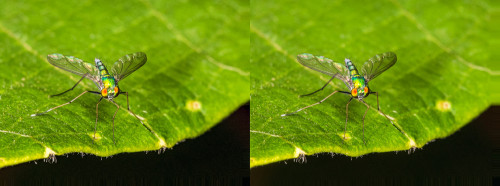
Unlike the vast majority of insects that flee upon being approached too closely, these dainty Long-legged flies are not easily spooked from their chosen perches, making them ideal photography subjects. Though, that being said, if you’re utilizing loud shutter click or a bright flash, they will invariably jump up, but will eventually settle down. If you’re persistent and choose to diffuse the flash a wee bit you can capture them well. I used the silent shutter option of Canon EOS 5D Mark III and captured it with Canon EF 100mm f/2.8L Macro IS USM fitted with Canon MT-24EX macro twin light flash. I diffused the Canon MT-24EX flash with a half cut plastic cup, thereby allowing the light to spread evenly, in a significantly better fashion.

Long-legged flies, Family Dolichopodidae, make up quite a large family and together with the shore flies, Family Ephydridae, are amongst the most common true flies to be encountered along the shores of our ponds, lakes and streams.

Unlike the pesky houseflies, which are nuisance mongers, Long Legged flies are beneficial, in that they prey upon insect pests such as mites, aphids, flea hoppers, booklice, thrips, silverfish, caterpillars and even other files, amongst others, so that they are desirable, perhaps even welcome guests, in the yard and garden.

Long legged flies range in size from 1-9 mm., and as is evident from the photographs presented here, for your viewing pleasure, they posses some of the nicest pairs of legs to be found in the crawling kingdom, and with a slender figure to boot, are fully capable of making any model that ever walked the ramp, green with envy.

Sporting brilliant, metallic hues, in shades green, bronze and blue, there are over 7000 species of these beautiful flies, placed in about 200 genera, the world over.

The larvae, which are typically maggot like in form and shape, are found in damp soil or amidst mossy boulders, in the immediate vicinity of their favored habitats, namely marshes, ponds, rivers and streams. When the final instar spins a cocoon it encapsulates soil particles and assorted pieces of debris from the earth, into its little package.

Since these oft overlooked insects are quite sensitive to changes in the local environment, they make useful indicators for site quality assessment in the field of conservation biology, planning and development. An area with a high Dolichopodid diversity is generally considered to be a healthy, unperturbed site, whereas a low diversity is an indication of a disturbed, environmentally unsound habitat.

Here is cross-eyed stereogram of the same fly which is shown above. Cross your eyes till you see three images using these two. If you can’t focus well, move backwards till the center image comes into focus. It should be in 3D 🙂 It is easy to create these stereograms. I used 2 images which are stacked together in Zerene stacker. Once stacking is done, it can create these type of cross eye stereogram on the fly 😉 Learn more about it in Zerene stacker website – Synthetic Stereo & 3-D Rocking
Adult long legged flies will sometimes visit flowers for nectar, in order to meet their carbohydrate requirements, so remember to include some flowering plants in your garden. 😉


I had a very tough time capturing this fly with the camera’s pop-up flash. Later, I guessed it reacts to light and took without the flash. Next time if I see this, I will try the technique you have specified.